These homemade sourdough English muffins have the perfect chewy texture, a mild tangy flavor, and the signature nooks and crannies that make them so satisfying. Unlike store-bought versions, they contain no preservatives and develop a deep, complex taste through the natural fermentation process. Whether toasted with butter, used for breakfast sandwiches, or as the base for eggs Benedict, these muffins are a versatile addition to any kitchen.
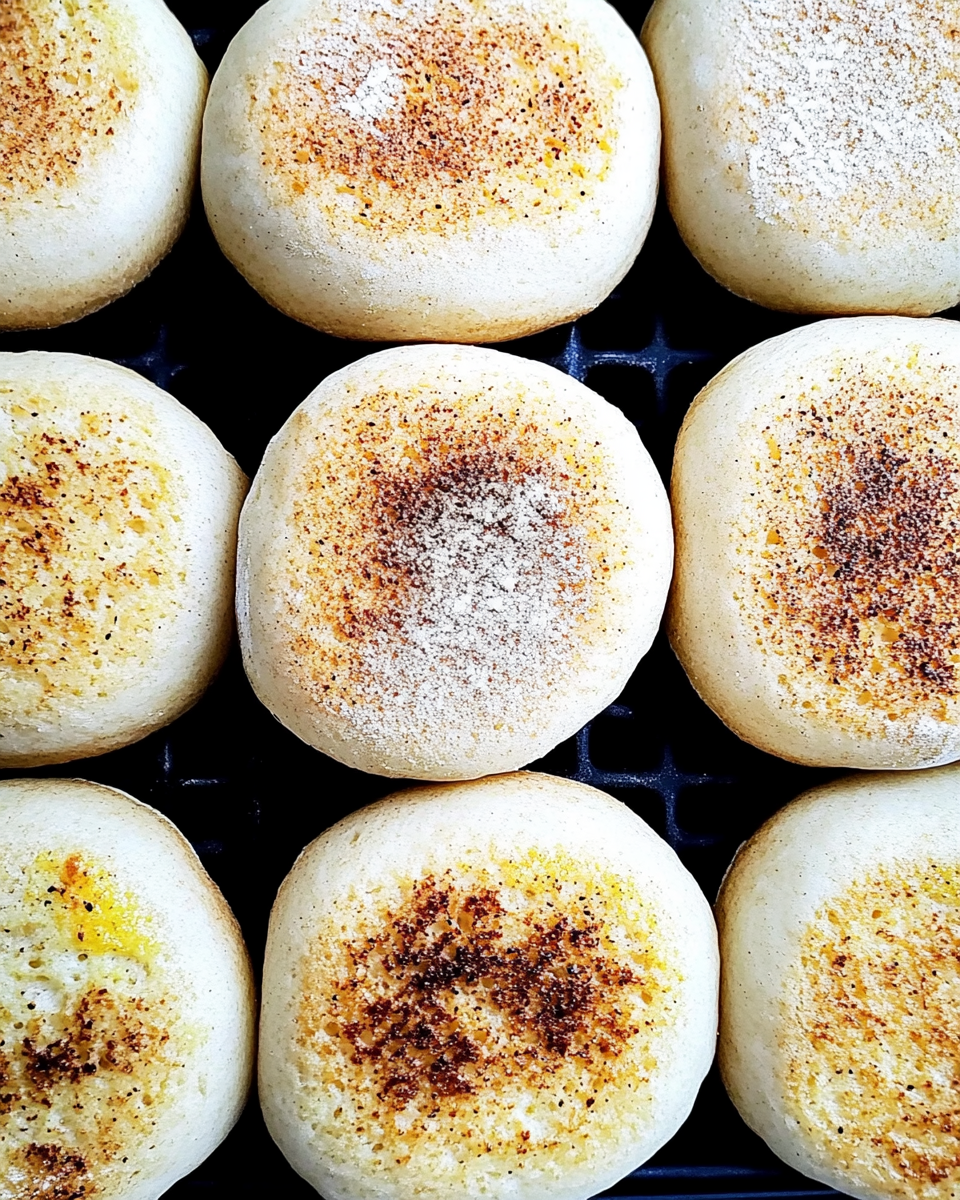
One of the best parts about making English muffins from scratch is the ability to control the ingredients and fermentation process. The long, slow rise with an active sourdough starter enhances their flavor and gives them a light, airy interior. They’re also freezer-friendly, making them an excellent choice for meal prep.
Why You’ll Love This Recipe
- Deep, Tangy Flavor – Naturally fermented for a rich taste.
- No Yeast Needed – Leavened entirely with sourdough starter.
- Perfect for Breakfast – Ideal for toasting, sandwiches, or eggs Benedict.
- Meal Prep Friendly – Freeze and reheat easily for busy mornings.
- Better Than Store-Bought – No preservatives or artificial ingredients.
Preparation Phase & Tools to Use
Essential Tools and Equipment
- Mixing Bowls – For preparing and fermenting the dough.
- Stand Mixer (Optional) – Speeds up kneading but is not required.
- Rolling Pin – Helps achieve even dough thickness.
- Round Cutter (3-4 inches) – Ensures uniform muffin size.
- Baking Sheet – For resting the shaped muffins before cooking.
- Griddle or Skillet – Used to cook the muffins on the stovetop.
- Instant-Read Thermometer – Ensures muffins reach 190°F internally.
Preparation Tips
- Use an Active Starter – Feed your starter 4-6 hours before mixing.
- Ferment Overnight – This enhances flavor and texture.
- Handle Dough Gently – Avoid over-kneading to keep the muffins light.
- Use Cornmeal or Semolina – Prevents sticking and adds a classic texture.
Ingredients
The Night Before (8 Hours Before)
- 1 cup active sourdough starter (100% hydration)
- 2 tablespoons honey
- 2 cups milk
- 4 cups unbleached all-purpose flour
The Next Morning
- 1 teaspoon baking soda
- 2 teaspoons salt
- 1–2 cups unbleached all-purpose flour
To Cook the English Muffins
- Cornmeal, semolina, or farina for dusting
Step-by-Step Directions
1. The Night Before
- In a medium bowl, combine the sourdough starter, milk, honey, and 4 cups of flour.
- Stir until a thick, sticky dough forms.
- Cover and let sit at room temperature for 8–10 hours to ferment.
2. The Next Morning
- Add baking soda, salt, and 1 cup of flour to the dough.
- Knead until smooth (5 minutes in a stand mixer or 10 minutes by hand), adding more flour as needed.
- Let the dough rest for 10–15 minutes before shaping.
3. Shape the Muffins
- Roll the dough to ½-inch thickness on a lightly floured surface.
- Use a 3-4 inch round cutter or a drinking glass to cut out circles.
- Place on a greased baking sheet dusted with cornmeal.
- Cover loosely with oiled plastic wrap and let rise for 1 hour.
4. Cook the Muffins
- Preheat a griddle to 325°F or heat a pan over medium-low heat.
- Sprinkle with cornmeal, semolina, or farina to prevent sticking.
- Place muffins on the griddle, cooking for 5–6 minutes per side.
- Check that the center reaches 190°F before removing from heat.
Serving Suggestions
Classic Buttered & Toasted
Sourdough English muffins develop an incredible texture when toasted. Split them with a fork to preserve the nooks and crannies, then toast until golden brown. Add butter while they’re warm for a simple yet satisfying bite.
Jam & Honey
For a sweet option, spread them with homemade jam, fruit preserves, or honey. The tangy sourdough pairs well with berry-based jams like raspberry or strawberry.
Avocado Toast
Top a toasted muffin with mashed avocado, a pinch of sea salt, red pepper flakes, and a drizzle of olive oil. Add a poached egg for extra protein.
Eggs Benedict
Use these muffins as the base for eggs Benedict. Top with Canadian bacon, a poached egg, and hollandaise sauce for a restaurant-quality brunch.
Breakfast Sandwiches
Make a hearty breakfast sandwich by layering eggs, cheese, and bacon or sausage between two halves of a toasted muffin. For a healthier twist, use turkey bacon or add fresh spinach.
Peanut Butter & Banana
For a protein-packed snack, spread peanut butter on a toasted muffin and top with banana slices and a sprinkle of cinnamon.
Smoked Salmon & Cream Cheese
For a gourmet option, spread cream cheese on a toasted muffin and top with smoked salmon, capers, and thinly sliced red onion.
Savory Melt
Turn your muffins into a mini pizza by topping them with marinara sauce, mozzarella cheese, and pepperoni. Toast under the broiler until the cheese melts.
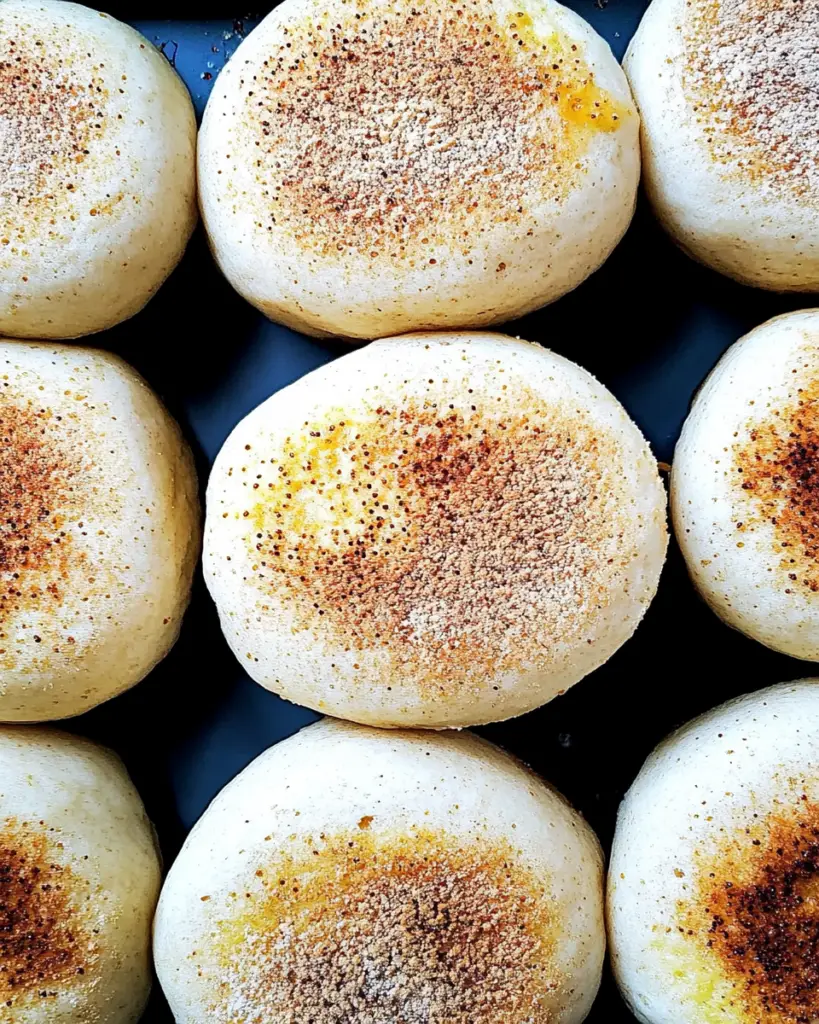
Common Mistakes to Avoid
Even though making homemade sourdough English muffins is straightforward, a few mistakes can impact the final result. Here’s how to avoid common pitfalls.
1. Using an Inactive Sourdough Starter
An inactive or weak starter will prevent the muffins from rising properly, making them dense. Ensure your starter is bubbly and active before using it. Feed it 4-6 hours before mixing the dough.
2. Skipping the Overnight Fermentation
The long fermentation process gives the muffins their signature sourdough flavor and improves texture. Skipping this step will result in a bland, underdeveloped taste.
3. Over-Kneading the Dough
Unlike traditional bread, English muffin dough should not be overworked. Knead just until the dough is smooth and elastic, about 5 minutes in a stand mixer or 10 minutes by hand. Over-kneading can make the muffins tough.
4. Rolling the Dough Too Thin
For properly sized muffins, roll the dough to about ½-inch thickness. If it’s too thin, the muffins won’t have enough height, leading to flat, dense results.
5. Cooking Over High Heat
A common mistake is setting the griddle or skillet too hot. This causes the muffins to brown too quickly on the outside while remaining undercooked inside. Keep the heat on medium-low and cook slowly for even results.
6. Not Checking Internal Temperature
The best way to ensure your muffins are fully cooked is to check the internal temperature with an instant-read thermometer. They should reach 190°F in the center. If they’re undercooked, the inside will be doughy.
7. Cutting with a Knife Instead of a Fork
To maintain the classic nooks and crannies, split the muffins with a fork rather than slicing them with a knife. This preserves their light, airy structure and helps them toast better.
Best Side Dishes to Serve with Sourdough English Muffins
Pair your muffins with a delicious side to create a complete meal. Here are some of the best options:
- Scrambled Eggs – A simple yet classic pairing for a hearty breakfast.
- Hash Browns – Crispy potatoes add a great contrast to the soft muffins.
- Fresh Fruit Salad – A refreshing and light side that balances the tangy muffins.
- Greek Yogurt & Granola – Adds protein and a bit of crunch for a balanced meal.
- Sautéed Mushrooms – A savory topping that pairs well with eggs or cheese.
- Bacon or Sausage – A traditional breakfast side that complements the muffins.
- Smoked Salmon & Capers – Adds a gourmet touch with a rich, salty flavor.
- Maple-Glazed Ham – A sweet and savory combination that enhances the muffins.
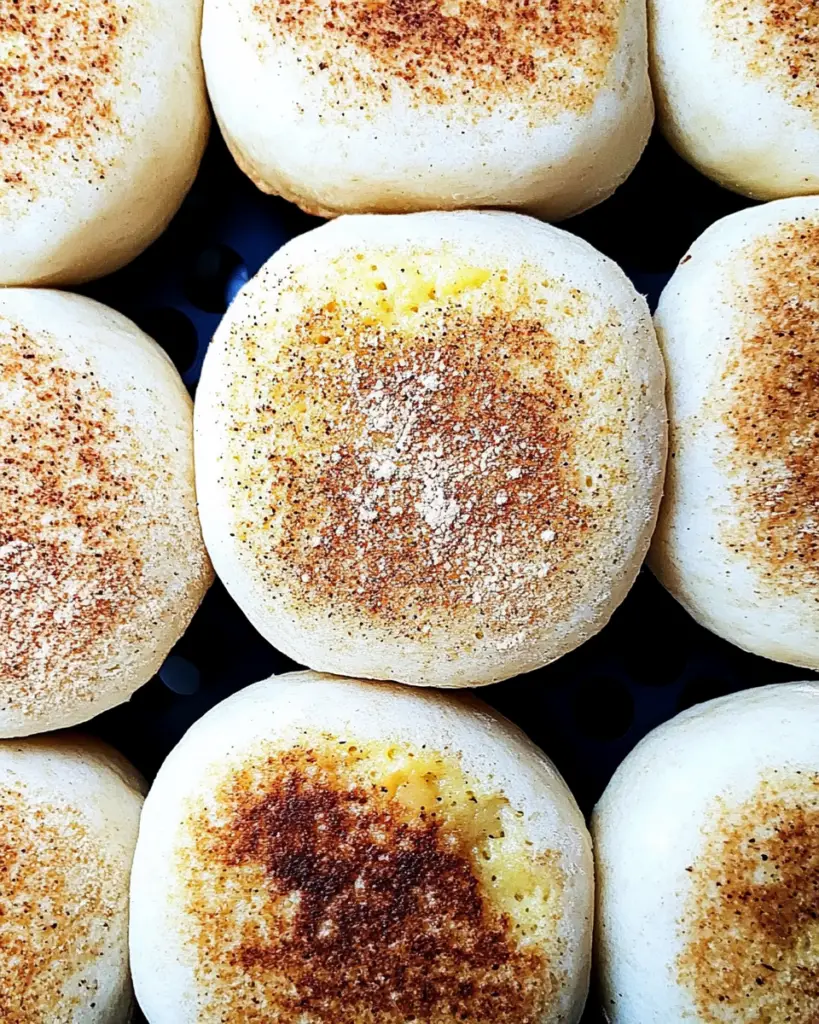
Recipe Tips for the Best English Muffins
1. Use a Well-Fed Sourdough Starter
For the best rise and flavor, your starter should be active and bubbly. Feed it 4-6 hours before mixing the dough to ensure it’s at peak activity.
2. Allow for a Full Fermentation
Overnight fermentation develops the tangy sourdough flavor and gives the dough a lighter texture. Rushing this step will result in a dense, bland muffin.
3. Control the Dough Consistency
The dough should be soft but not overly sticky. If it’s too dry, the muffins will be tough. If too wet, they may not hold their shape. Add flour gradually to achieve the right consistency.
4. Cook at Low to Medium Heat
Cooking at too high a temperature causes the outside to brown before the inside is fully cooked. A medium-low heat setting ensures even cooking.
5. Flip Only Once
Turn the muffins just once during cooking. Flipping them too often can prevent them from rising properly.
6. Check for Doneness
Use an instant-read thermometer to check that the internal temperature has reached 190°F. If the muffins are undercooked, they will be gummy inside.
7. Split with a Fork for the Best Texture
Using a fork instead of a knife preserves the signature nooks and crannies, allowing the muffins to toast perfectly.
Storage Instructions
Short-Term Storage (Up to 3 Days)
- Store muffins in an airtight container or resealable bag at room temperature.
- Keep them in a cool, dry place to prevent them from drying out.
Refrigeration (Up to 1 Week)
- For longer freshness, refrigerate in a sealed container.
- Reheat before serving, as refrigeration can make them slightly firm.
Freezing (Up to 1 Month)
- Allow muffins to cool completely before freezing.
- Place in a freezer-safe bag, removing as much air as possible.
- For best results, split before freezing to make toasting easier.
Reheating Instructions
Toaster or Oven Method
- Preheat the oven to 350°F or use a toaster.
- Toast until golden brown and crisp.
Skillet Method
- Heat a dry skillet over medium heat.
- Warm each side for 1-2 minutes until toasted.
Microwave Method
- Wrap in a damp paper towel.
- Heat for 10-15 seconds on medium power.
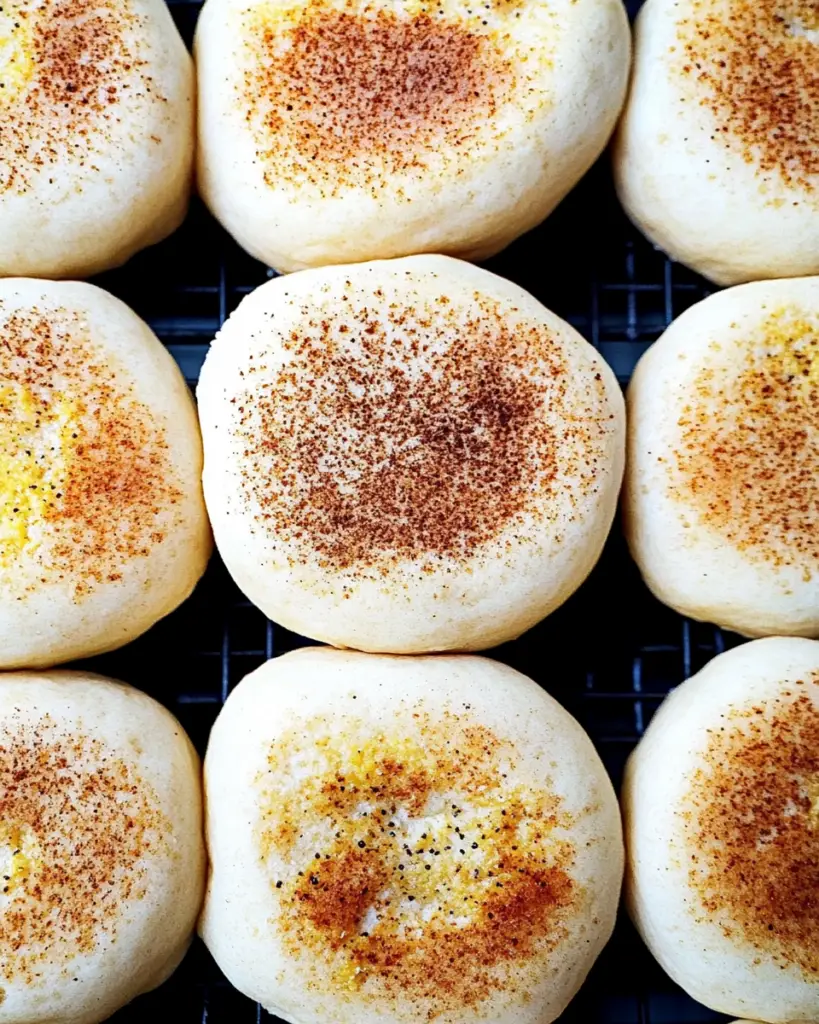
FAQs
1. Can I Use Sourdough Discard Instead of Active Starter?
Yes, but you’ll need to add commercial yeast for leavening. Replace the baking soda with 2-3 teaspoons of instant yeast, and let the dough rise for 1-1.5 hours before shaping.
2. Why Are My Muffins Too Dense?
This can happen if your starter wasn’t active enough, the dough was over-kneaded, or you added too much flour. Ensure the starter is bubbly and avoid overworking the dough.
3. Can I Bake These Instead of Cooking on a Griddle?
Yes, bake them at 350°F for 12-15 minutes, flipping once halfway through for even cooking. However, a griddle gives the muffins their signature crust.
4. How Do I Get More Nooks and Crannies?
- Let the dough rise fully before cooking.
- Do not over-knead.
- Always split the muffins with a fork rather than slicing with a knife.
5. Can I Make These Dairy-Free?
Yes, substitute the milk with plant-based alternatives like almond, oat, or coconut milk.
6. How Can I Make a Sweeter Version?
Increase the honey or add a tablespoon of sugar to the dough for a slightly sweeter taste.
Conclusion
Making homemade sourdough English muffins is well worth the effort, providing a fresher, more flavorful result than anything from the store. With a crispy crust, a soft, airy interior, and the signature nooks and crannies, they are perfect for breakfast, sandwiches, or a quick snack.
By following the tips, avoiding common mistakes, and storing them properly, you can enjoy these muffins anytime. Whether toasted with butter, turned into eggs Benedict, or used for a hearty breakfast sandwich, they are a versatile and delicious addition to any kitchen.
Homemade Sourdough English Muffins
Ingredients
The Night Before (8 hours before):
- 1 cup active sourdough starter 100% hydration*
- 2 tablespoons honey
- 2 cups milk
- 4 cups all-purpose flour unbleached
The Next Morning:
- 1 teaspoon baking soda
- 2 teaspoons salt
- 1 –2 cups all-purpose flour unbleached
To Cook the English Muffins:
- Cornmeal semolina, or farina for dusting
Instructions
The Night Before
- In a medium bowl, mix the sourdough starter, milk, honey, and 4 cups of flour.
- Cover the bowl and leave it on the counter at room temperature for 8–10 hours, depending on the activity level of your starter.
The Next Morning
- Add baking soda, salt, and 1 cup of flour to the mixture. Knead the dough until smooth (5 minutes using a stand mixer or 10 minutes by hand), adding more flour as needed if the dough is too sticky.
- Let the dough rest for 10–15 minutes.
Shape the Muffins
- Roll the dough out to about 1/2-inch thickness.
- Use a 3–4 inch round cutter or glass to cut circles. Place the rounds on a lightly greased baking sheet dusted with cornmeal.
- Reroll scraps to make up to 18 small muffins or divide the dough into 9 pieces for large muffins.
- Cover the muffins loosely with sprayed/oiled plastic wrap and allow them to rise for about 1 hour.
Cook the Muffins
- Preheat a griddle to 325°F or heat a pan over medium-low heat. Generously sprinkle the griddle/pan with cornmeal (or semolina/farina).
- Place a few muffins on the griddle or pan at a time. Cook for 5–6 minutes per side, covering the pan if possible to help them cook evenly.
- The center of the muffins should register 190°F when done (use an instant-read thermometer).


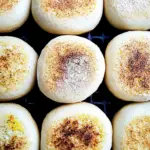



Leave a Comment